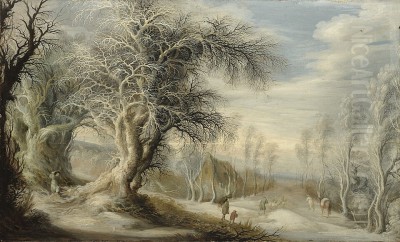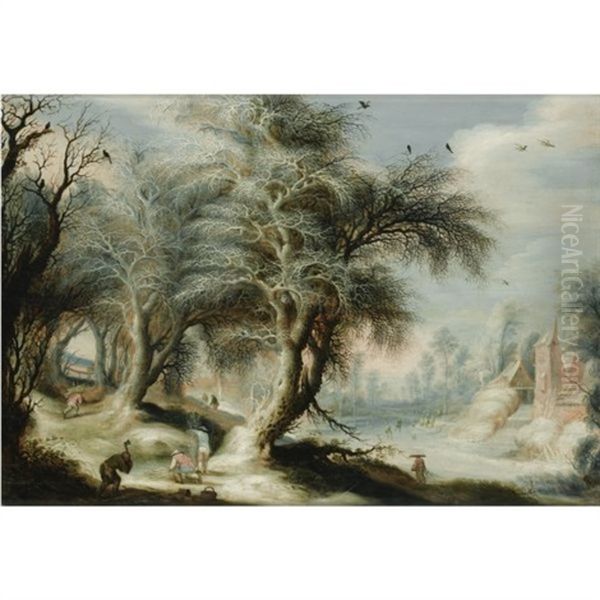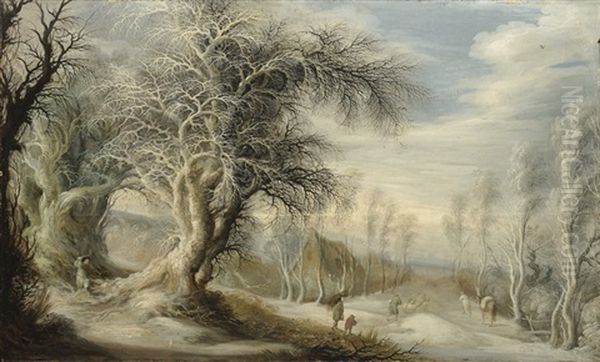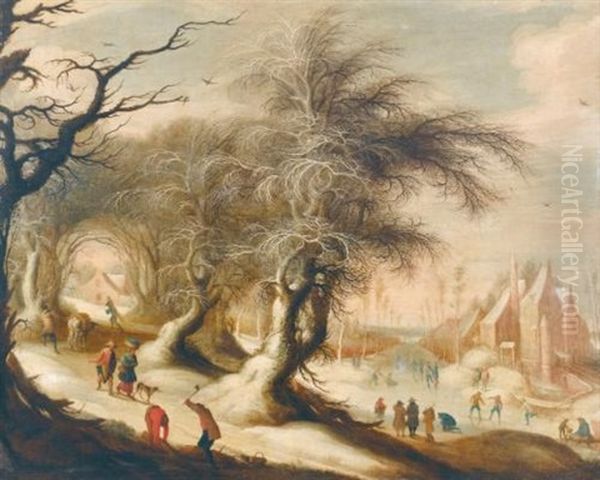
Gysbrecht Leytens, a name that resonates with the crisp air and frosted beauty of 17th-century Flemish winter landscapes, remains a figure of intrigue and profound artistic merit. For many years, his distinct and evocative works were attributed to an anonymous hand, dubbed the "Master of the Winter Landscapes." It was only through dedicated art historical research in the 20th century that his identity was firmly established, allowing us to fully appreciate the unique vision of this Antwerp painter. His canvases, often dominated by majestic, snow-laden trees, transport viewers to a world of serene, frozen stillness, punctuated by the quiet activities of rural life.
Early Life and Artistic Emergence in Antwerp
Gysbrecht Leytens was born in Antwerp in 1586, a city that stood as a vibrant hub of artistic innovation and production in the Southern Netherlands. The precise details of his early training remain somewhat obscure, as is common for many artists of this period. However, it is documented that he became a master in the prestigious Antwerp Guild of Saint Luke in 1611. This admission signifies that he had completed his apprenticeship under a recognized master and was now qualified to take on his own pupils and sell his works independently. The Guild was a cornerstone of artistic life, regulating standards and fostering a community of painters, sculptors, and craftsmen.
The artistic environment in Antwerp during Leytens' formative years was rich and varied. He would have been aware of the towering figures of the previous generation, such as Pieter Bruegel the Elder, whose own winter scenes had set a precedent for the genre. Contemporaries like Jan Brueghel the Elder, with his meticulously detailed landscapes and allegories, and Joos de Momper, known for his expansive, often mountainous, vistas, were shaping the landscape tradition. Leytens would carve his own niche within this dynamic milieu, focusing with singular intensity on the motif of the winter forest.

Beyond his artistic pursuits, Leytens was an active member of Antwerp society. He is recorded as a member of the "Olijftak" (Olive Branch), one of Antwerp's chambers of rhetoric, from 1615 to 1625. These societies were important cultural institutions, fostering literature, poetry, and drama. Furthermore, he served as a captain of the Antwerp civic guard (Schutterij) between 1624 and 1628 (some sources suggest until 1626). These roles indicate a man of some standing within his community, involved in both its cultural and civic defense.
The Enigma of the "Master of the Winter Landscapes"
For a significant period, the distinctive body of work now attributed to Gysbrecht Leytens was known only by the moniker "Meister der Winterlandschaften" or the "Master of the Winter Landscapes." This anonymity was partly due to his often cryptic or minimal way of signing his works. Many of his paintings bear only the monogram "G L," or sometimes just an "A" (perhaps for Antwerpen), which made definitive attribution challenging for early art historians. His style, however, was so consistent and recognizable that scholars knew these works emanated from a single, highly skilled hand.
The breakthrough in identifying Gysbrecht Leytens as this enigmatic master came relatively late. While the distinctive group of winter scenes was first recognized as the work of a single artist around 1940, it wasn't until 1988 that art historian Dr. Ursula Härtung conclusively linked the "Master of the Winter Landscapes" to Gysbrecht Leytens. This identification was solidified through the discovery of a fully signed painting, which provided the crucial link between the known name and the established oeuvre. This revelation allowed for a more focused study of his life and his specific contribution to Flemish Baroque art.
The delay in his identification underscores the complexities of art historical research, especially for artists who may not have achieved the same level of contemporary fame as figures like Peter Paul Rubens or Anthony van Dyck, but whose work nonetheless possesses exceptional quality and originality. Leytens' case is a testament to the meticulous scholarship that can restore an artist to their rightful place in history.
A Signature Style: The Poetry of Trees and Frost
Gysbrecht Leytens' artistic signature is inextricably linked to his profound and poetic depiction of trees, particularly in winter settings. His forests are not mere backdrops but are the dominant protagonists of his compositions. The trees are often rendered with an almost fantastical quality, their branches gnarled, sinuous, and laden with meticulously painted snow or hoarfrost. These arboreal giants possess an anthropomorphic character, their forms contorting and reaching, creating intricate silhouettes against pale, luminous skies.

His technique involved a delicate application of paint, capturing the subtle gradations of light and shadow on snow-covered surfaces. The palette is typically cool, dominated by whites, blues, greys, and earthy browns, which perfectly evoke the chill of winter. However, he often introduced subtle warm accents in the clothing of figures or the distant glow of a sunset, preventing the scenes from becoming monotonous and adding a touch of human warmth to the otherwise stark environment. The play of light is crucial; often, a low sun casts long shadows, or a diffused light filters through the dense canopy, creating an ethereal, almost magical atmosphere.
Leytens' compositions are carefully constructed, often using a diagonal recession to lead the viewer's eye deep into the forest. The foreground is typically detailed, with a focus on the textures of bark, frozen ground, and individual snowflakes, while the background recedes into a softer, more atmospheric haze. This creates a convincing sense of depth and space, drawing the observer into the silent, frozen world he portrays. His ability to render the specific textures of winter – the powdery softness of fresh snow, the crystalline sharpness of ice, the brittle delicacy of frosted twigs – is remarkable and sets his work apart.
Themes and Motifs in Leytens' Oeuvre
While the overarching theme of Gysbrecht Leytens' work is the winter landscape, his paintings are often populated with small figures engaged in various rural activities. These figures, though subordinate to the grandeur of nature, add narrative interest and a sense of scale to his compositions. We see woodcutters felling trees or gathering firewood, hunters with their dogs traversing the snowy paths, peasants driving laden sledges, or skaters enjoying frozen ponds and rivers. These genre elements connect his work to a broader tradition in Flemish and Dutch painting that celebrated everyday life.
However, unlike some of his contemporaries, such as Hendrick Avercamp in the Northern Netherlands, whose winter scenes often teem with anecdotal detail and bustling crowds, Leytens' figures are generally more subdued and integrated into the landscape. They seem to exist in harmony with, or sometimes in quiet struggle against, the formidable power of nature in winter. The emphasis remains firmly on the atmospheric depiction of the forest itself, with its towering, frost-covered trees.

The recurring motif of the dense, almost impenetrable forest, often with a path winding through it, can be interpreted in various ways. It can symbolize the journey of life, the challenges of nature, or simply a deep appreciation for the untamed beauty of the wilderness. The silence and stillness that pervade many of his scenes evoke a contemplative mood, inviting the viewer to reflect on the serene yet harsh realities of the winter season. His works are less about specific locations and more about capturing a universal experience of winter's embrace.
Representative Works: Visions in White
Several key works exemplify Gysbrecht Leytens' unique style. One of his most characteristic paintings is often titled "Winter Landscape with Woodcutters" or similar variations, a theme he revisited. In such a piece, one would typically see a dense forest, the trees heavy with snow, their branches forming intricate patterns against a cold sky. Small figures of woodcutters are at work, their activity almost absorbed by the overwhelming presence of the snow-covered woods. The meticulous rendering of frost on every twig and the subtle play of light filtering through the trees are hallmarks of his approach.
Another significant example is "Winter Landscape Animated with Villagers" (or similar titles found in various collections). This painting, like many others, showcases his mastery in depicting the intricate, lace-like patterns of snow on tree branches. Villagers might be seen transporting goods or simply navigating the frozen terrain, their colorful attire providing small focal points within the predominantly cool palette. The sheer scale of the trees often dwarfs the human figures, emphasizing nature's dominance.
While winter scenes were his specialty, Leytens also produced some non-winter landscapes. A notable example is "Mountain Landscape in the Rain," which demonstrates his ability to capture different atmospheric conditions. Though less common, these works reveal a broader interest in landscape painting beyond his signature winter motifs, showcasing his skill in depicting varied terrains and weather effects, possibly influenced by artists like Joos de Momper or even earlier masters like Joachim Patinir who pioneered dramatic mountainscapes.
His works can be found in numerous prestigious museums, including the Rijksmuseum in Amsterdam, the Royal Museums of Fine Arts of Belgium in Brussels, and the Hermitage Museum in St. Petersburg, attesting to their enduring appeal and art historical importance.
Collaborations, Contemporaries, and Influences
Gysbrecht Leytens operated within a thriving artistic community in Antwerp, and collaborations between artists specializing in different areas (e.g., landscape, figures, still life) were common. It is documented that Leytens collaborated with other painters, who would sometimes add the figures (staffage) to his landscapes. Among those he is known to have worked with are Frans Francken II and Sebastiaen Vrancx. Frans Francken II, part of a large family of painters, was known for his small-scale cabinet pictures with historical, mythological, or allegorical scenes, and his lively figures would have complemented Leytens' atmospheric settings. Sebastiaen Vrancx was a specialist in battle scenes and genre subjects, including depictions of robbers attacking travelers, which could be dramatically set within Leytens' wooded landscapes.
Leytens also had at least one documented pupil, Jan van de Veur (sometimes recorded as Jacques van de Veur or Jan de Vries), whom he taught, passing on his skills in landscape painting. The influence of his training and style can sometimes be traced in the works of artists who followed.
Beyond direct collaborations, Leytens' work should be seen in the context of his contemporaries. He was clearly influenced by the earlier generation of Flemish landscape painters, particularly Pieter Bruegel the Elder, whose "Hunters in the Snow" (1565) is an iconic precursor. The tradition of detailed forest interiors was also advanced by artists like Gillis van Coninxloo and Jan Brueghel the Elder. Leytens took these traditions and infused them with his own highly personal and recognizable style.
Other landscape specialists active in Antwerp or the broader Southern Netherlands during Leytens' time included Abraham Govaerts, who also painted wooded landscapes, often with a similar density but perhaps a different atmospheric touch. Alexander Keirincx was another contemporary known for his forest scenes. Further north, in the Dutch Republic, artists like Hendrick Avercamp and Esaias van de Velde were popularizing winter scenes, though often with a greater emphasis on human activity and a more open compositional structure compared to Leytens' dense forests. One might also consider the work of Denis van Alsloot, who, active in Brussels, also produced notable winter landscapes, sometimes with a slightly more courtly feel. The broader European context includes artists like Adam Elsheimer, a German painter active in Rome, whose poetic small-scale landscapes with innovative light effects influenced many Northern artists. Leytens' unique focus on the monumental, almost surreal quality of snow-laden trees, however, distinguishes his contribution.
Later Career and Enduring Legacy
Information regarding the later part of Gysbrecht Leytens' life and career, including his exact date of death, has been subject to some historical ambiguity. While earlier accounts sometimes cited a death year around 1628, more recent scholarship suggests he was active for a longer period, possibly until 1643 or even as late as 1656. This extended period of activity would mean he continued to produce his distinctive winter landscapes well into the mid-17th century, witnessing further evolutions in Flemish and Dutch art.
Regardless of the precise timeline, Leytens' legacy is primarily defined by his unique and highly specialized contribution to landscape painting. He took the established genre of the winter scene and imbued it with a deeply personal, almost mystical quality. His focus on the intricate and often exaggerated forms of trees, laden with snow and frost, created a visual poetry that was unmatched by his contemporaries in its specific intensity.
Even when his name was obscured under the "Master of the Winter Landscapes" moniker, the quality and distinctiveness of his work were recognized. The eventual reattribution of these paintings to Gysbrecht Leytens has allowed for a fuller appreciation of his individual genius. He stands as a significant figure in the Antwerp School, a specialist who, within his chosen niche, achieved a remarkable level of artistry and evocative power. His paintings continue to captivate viewers with their silent, frozen beauty, offering a timeless glimpse into the heart of a 17th-century winter. His influence can be seen in the way subsequent landscape artists approached the textures and atmosphere of winter, even if they did not directly emulate his unique style. He remains a testament to the rich diversity of talent within the Flemish Baroque.
Conclusion: The Frosty Brush of Gysbrecht Leytens
Gysbrecht Leytens, once a shadowy figure known only through a distinctive style, has rightfully emerged as a significant master of Flemish Baroque landscape painting. His life in Antwerp, his participation in the Guild of St. Luke, and his civic roles paint a picture of an artist integrated into his community. However, it is his artistic vision, expressed through his mesmerizing winter landscapes, that secures his place in art history.
His unparalleled ability to capture the essence of a snow-covered forest, with its towering, intricately frosted trees and serene, often melancholic atmosphere, sets him apart. Works like "Winter Landscape with Woodcutters" and his various depictions of villagers navigating frozen terrains are not merely representations of a season; they are poetic meditations on nature's grandeur and the quiet human presence within it. His collaborations with figures like Frans Francken II and Sebastiaen Vrancx, and his position within a lineage of landscape painters that includes giants like Pieter Bruegel the Elder and contemporaries like Joos de Momper and Jan Brueghel the Elder, highlight his engagement with the vibrant artistic currents of his time.
Though the details of his full biography may still hold some mysteries, the power of his canvases is undeniable. Gysbrecht Leytens remains the "Poet of Frost," an artist whose brush transformed the ordinary winter scene into a realm of enchanting, frozen beauty, leaving an indelible mark on the tradition of landscape painting. His works invite us to step into the stillness of his world, to marvel at the delicate artistry that brings the chill and wonder of winter to life.